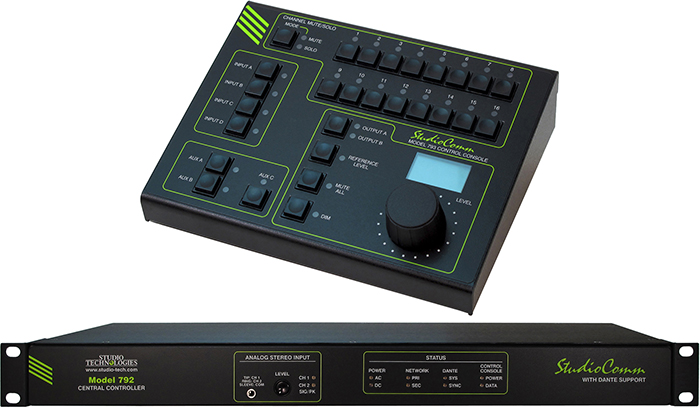At the upcoming NAB 2020 show in Las Vegas, Studio Technologies (booth C7049) will present its newly announced Studiocomm Dante Audio-over-IP-enabled multichannel monitoring system, made up of the Model 792 central controller and Model 793 control console.
The new system combines a rack-mounted main electronics unit with a desktop user control surface, and the signal path uses programmable logic to support both digital and analog audio. A set of configuration features allow the system to support immersive formats that include 5.1.4, 7.1.4, and 10.2.
“We’ve designed this system to fit easily into any professional multichannel environment,” says Gordon Kapes, president of Studio Technologies. “More and more studios are switching to Dante and AES67 networked audio infrastructures, but they still need to support analog – this system provides both. As with all Studio Technologies products, users can be confident that what they hear on the output is extremely close to what went in – nothing more.”
The Model 792 central controller has multiple digital and analog inputs with configurable time delay, source selection, and level control. Digital and analog outputs support formats of up to 16 channels. Analog 2-channel inputs and outputs offer support for stereo reference signals. Trim levels, delays, dim and reference level, and pre/post outputs can be optimized using the system’s built-in web server-based menu pages. An FPGA-based 32-bit audio architecture is designed to offer high headroom and high audio quality.
The multichannel analog I/O stems use the Model 792’s rear-panel 25-pin D-subs in banks of eight channels, while a front panel 3.5 mm stereo jack and level control provides a 2-channel input for laptops, phones, and other stereo reference feeds. The digital audio I/O uses two Gigabit Ethernet interfaces to support switched and redundant Dante. A separate GigE Ethernet interface provides access to the Model 792’s management web pages. These allow connection to fully-independent audio and management networks. The unit also features both universal AC mains and 10-18-volt DC inputs, which allow redundant power supply operation.
All analog and Dante sources have independent level trim controls. Input signal delay of up to 999 milliseconds allows synchronization with video display latency. On the output side, all Dante and analog channels have independent trim controls, pre- and post-fader source selection, selectable dim attenuation, user-definable reference levels, and custom labelling for the multichannel and stereo stems.
The Model 793 control console provides selection of all sources and outputs, reference level, dim function, mutes, and solos. The user control surface has single-function buttons and a high-resolution encoder along with a graphics display. Four user=definable input stems and two outputs are directly selectable on the front panel, along with mute/solo buttons for every individual channel. Users can also select dim, reference level, and mute all functions. The rotary encoder supports level control for stems of up to 16-channels. The graphics display provides numerical level and status information, along with important system information such as the system’s LAN IP addresses.
“We have been developing Dante networked audio solutions for several years now,” Kapes adds. “This system is an important step forward for us and represents excellent value and flexibility for any broadcast operation, post-production facility, or music studios that needs a robust, time-saving, and ergonomic networked audio solution.”















